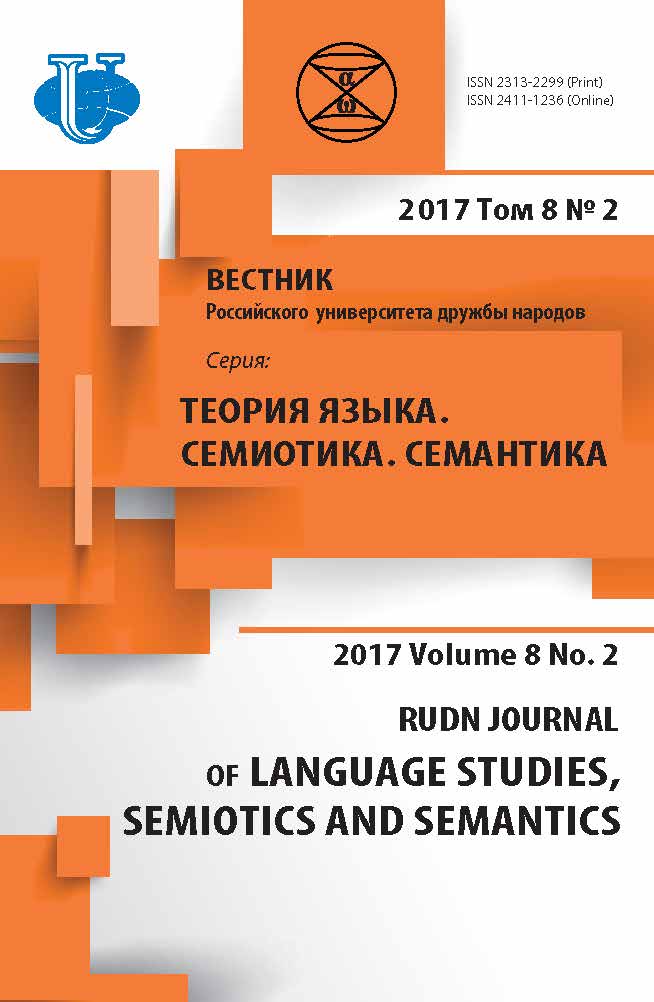Toponyms of the Largest Islands of Cape Verde
- Authors: Perfilieva N.V.1, Da Silva F.1
-
Affiliations:
- RUDN University
- Issue: Vol 8, No 2 (2017)
- Pages: 320-325
- Section: ARTICLES
- URL: https://journals.rudn.ru/semiotics-semantics/article/view/16340
- DOI: https://doi.org/10.22363/2313-2299-2017-8-2-320-325
- ID: 16340
Cite item
Full Text
Abstract
The article deals with the place names of the West African state of Cape Verde. It is known that the nomination of geographical features, continents, cities, natural features is closely linked to the history and culture of the peoples living in the area. In this connection it is of interest to explore the cultural component reflected in the place names of Cape Verde. The article also analyzes the toponyms in the etymological and structural aspects. Etymological analysis of toponyms involves their consideration in the aspect of the Luso-not-Portogallo of origin, focusing on etymological analysis that is due to this region. The paper proposes a classification according to the semantic criterion: the toponym is of anthropological origin. Structural analysis involves identifying groups of toponyms in the number of components, describes the following types of toponymic units: one word, a different compound, word types, a phrase and an idiom. The research centers on toponyms of Cape-Verde selected by the method of continuous sampling. However this article presents the examples of oikonym, oronym, hagionym, choronym as bearing the universal or national-specific information about the nomination. Some conclusions about the General and specific terms of toponymy of Cape Verde are given.
About the authors
Nataliya Vladimirovna Perfilieva
RUDN University
Author for correspondence.
Email: nperfilieva@yandex.ru
10/2, Miklukho-Maklaya st., Moscow, Russia, 117198
Francesca Da Silva
RUDN University
Email: dasilvafran66@yahoo.com
10/2, Miklukho-Maklaya st., Moscow, Russia, 117198
References
- Senna, Manuel Roiz Lucas de. (1987). Dissertação sobre as ilhas de Cabo Verde (1818). Anotações e comentários de António Carreira. Lisboa: Ediçãode António Carreira.
- Ohotin, N.V. ed. (1975). The language situation in Africa. Moscow: Nauka. (in Russ).
- Trubachov, O.N. (2012). Preface In: V.L. Vasiliev. Slavic place names of the Novgorod land of antiquity. Moscow: Handwritten monuments of Ancient Rus. (in Russ).
- Linguistic Encyclopedic Dictionary, ed. V.N. Yartseva. (1990). Moscow: “Soviet Encyclopedia”. (in Russ).
- Appiah, Kwame Anthony (1997). Na casa de meu pai: a África na filosofia da cultura. Rio de Janeiro: Contraponto.
- Stepanov, Ju.S. (1975). Methods and principles of modern linguistic. Moscow: Nauka. (in Russ).
- Zhuchkevich V.A. (1980). General toponyms. Minsk: Vysheishaya shkola.
- Gak, V.G. (1963) Comparative Typology of French and Russian languages. Moscow: Prosveshchenie. (in Russ).
- Bolekia Boleká, J. (2010). Las identidades minorizadas y la desconfiguraciôn del Estado / J. Bolekia Boleká. La palabra y la memoria: Guinea Ecuatorial 25 años después; L.-W. Miampika (ed.). Madrid: Editorial Verbum.
Supplementary files












